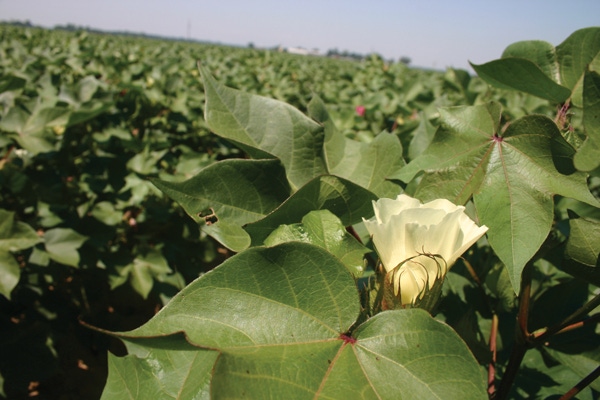June 15, 2012

A mild winter, early spring and timely rain have given Caddo County, Okla., cotton farmers' crop a good start.
Jeannie Hileman, manager of the Farmers Co-op gin in Carnegie says the 2012 crop has an early start, even with some attacks from cotton aphids on the young plants.
"We have a really good start this year," she said. "Much of the cotton is already at the pinhead square stage, just before beginning to form new bolls on the bottom branches of the plant. We have seen a lot of thrips in some fields. Seed treatments helped in the early stages of growth, but several producers have had to spray for the pest."
Dr. Randy Boman, Oklahoma State University Research Director and Cotton Extension Program Leader, accompanied by staffers Jerry Goodson and Shane Osborne, outlined how the 2012 cotton crop is shaping up to a group of Caddo County producers here this week.
Goodson, in the most recent edition of Cotton Comments, reported on the continuing problem of thrips in young cotton. "Thrips are not generally a serious pest of Oklahoma cotton except in years when unfavorable growing conditions limit early season growth. Heavy thrips infestations can occur if plants have emerged before wheat or other small grains mature. Mature thrips often move into stands of succulent cotton seedlings, causing curled and misshapen leaves, which inhibits growth and may cause maturity delay. Thrips infestations vary from field to field and from year to year and should be handled accordingly,” he said.
"Thrips are small, approximately one-sixteenth inch in length. The color varies according to species. It may be similar to the color of wheat straw, yellow, black or light brown. Adults have two pair of long, narrow-fringed wings that enable them to fly from one crop to another. The life cycle contains several stages: egg, larva, pupa and adult. Larvae and adults will overwinter in debris and trash near the field. In the spring, the adult females lay eggs by inserting them into the plant tissue.
“The creamy white eggs hatch into small larvae that feed on the plant. After a short time, they burrow into the soil and transform into a non-feeding stage called the pupae. They emerge as adults and continue to feed on the plant,” Goodson said.
"Thrips damage cotton by using their rasping-sucking mouth parts to feed on the plant surface. Ruptured cells release plant fluids, which are sucked up by the insects. Injury first appears as dark brown spots which assume a silvery appearance several days later. Feeding occurs on the lower side of the leaf and may injure the terminal bud so that new leaves fail to develop and growth is retarded. Leaves will be crinkled and cupped.
“Economically damaging infestations occur when plants average three thrips per plant at the three-leaf stage. Plants with fewer leaves can tolerate fewer thrips per plant, whereas larger plants can tolerate slightly higher populations. For questions concerning thrips, call the Altus Center.”
"Weekly scouting,” Goodson said, “is the only way to monitor a treatment's performance. Expect damaging populations of thrips to materialize first in fields where no at-planting insecticide was used. Windy conditions will impact a producer's ability to accurately assess thrips numbers. In-field detection becomes nearly impossible as the wind picks up. Take a composite sample pulling at least 30 plants across the field placing them in a plastic bag or bucket. Waiting to examine plants until you return to your vehicle will take longer, but it will be a lot more accurate.
Scouting
"Besides looking on the underside of cotyledons and true leaves, be sure to examine the terminal bud,” Goodson advised. “Both adults and immature thrips feed and lounge there and are easily overlooked unless you carefully inspect this region. Also, don't forget to count and record the numbers of dislodged thrips running around on the inside of the baggie.
"Crop demographics play a large role in thrips pressure. Wheat is widely known as an early season habitat for thrips. However, alfalfa is another thrips nursery that can produce large numbers of the insects. With each cutting, thrips migrate from the field in search of a food source. Cotton fields in close proximity to alfalfa meadows may experience a huge influx of thrips overnight that might rival the exodus from nearby wheat fields.”
Goodson said the amount of spring rainfall the area has received may mean a lot of other alternate hosts have provided considerable habitat for thrips to build populations.
"Finding adult thrips in protected fields is normal and is expected as long as the thrips migration continues,” he said. “Remember, thrips blown in from adjacent fields may not feed immediately and feeding is required for the insect to pick up a lethal dose of a systemic insecticide. Historically, Temik (aldicarb) has been a product of choice; however, with the loss of this product in 2011, farmers have come to rely more on seed treatments such as Gaucho (imidacloprid) or Cruiser (thiamethoxam) for early control. Other seed treatment products containing these products are also being sold," he said.
Over-the-top sprays can be used in fields planted to glyphosate-tolerant (Roundup Ready Flex and GlyTol) varieties. Tank mixing an insecticide with glyphosate is cost effective, Goodson said. Acephate (Orthene) has been a standard foliar thrips treatment for many years. Application rates can be found in the Cotton Comments, a periodical online production of the OSU Southwest Research and Extension Center staff.
For a table showing these products and expected length of control, inspect the May 15, 2012 edition of Cotton Comments located at www.ntokcotton.org. To receive Cotton Comments in your email, contact [email protected].
You May Also Like




